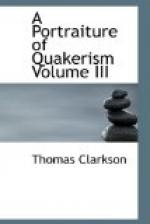Classical education again is considered as objectionable by the Quakers on account of the Heathen notions, which it may spread. Thus the highest reputation of man is placed in deeds of martial achievement, and a martial ardour is in consequence infused into youth, which it is difficult to suppress. That such notions and effect are produced, there can be no doubt; but how are we to avoid these whilst we are obliged to live in the world? The expulsion of the classics would not expel them. Our own newspapers, which are open to all, spread the same opinions, and are instrumental of course in producing the same excitements, but they do it in a much more objectionable way than the classical authors, that is, they do it with less delicacy, and with a more sanguinary applause. But where, as I observed before, shall we retire from such impressions? Does not the recruiting drum propagate them in all our towns? Do not the ringing of the bells, and the illuminations, which occasionally take place in the time of war, propagate them also? And do we not find these, both in war and in peace, the sentiments and impressions of the world? Our own notions then, our own writings, and our own customs, are more to be blamed in this respect, than the literary compositions of ancient times. But this, of all others, ought to be least an objection with the Quakers to such an education; because, to their honour, they have a constant counteraction of the effects of such sentiments and impressions in the principles of their own constitution, and which counteraction cannot cease, while, by the bearing of their testimony, they live in a continual protest against them.




